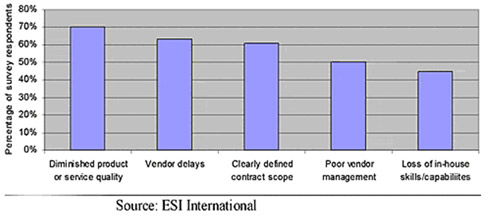Organizations that struggle with outsourced projects which have gone bad or failed completely usually cite vendor management issues as the reason. It’s as if the vendor is always to blame, and the buyer is completely blameless. Rarely is this the case. Upon closer inspection, and in nine out of 10 instances, the root cause of these often-unspecified vendor management problems that allegedly lead a project astray can be traced to poorly defined requirements. Although clear requirements are at the foundation of any project, they are even more critical for outsourced ones where the rule of law, in the form of a contractual relationship, governs the nature of the relationship between buyer and seller.
|
ADVERTISEMENT |
The results of a new survey conducted by ESI International show that the top risks of concern to organizations when outsourcing can also be traced to poor requirements management (figure 1).

Figure 1: Top five risks for outsourced projects
…
Add new comment